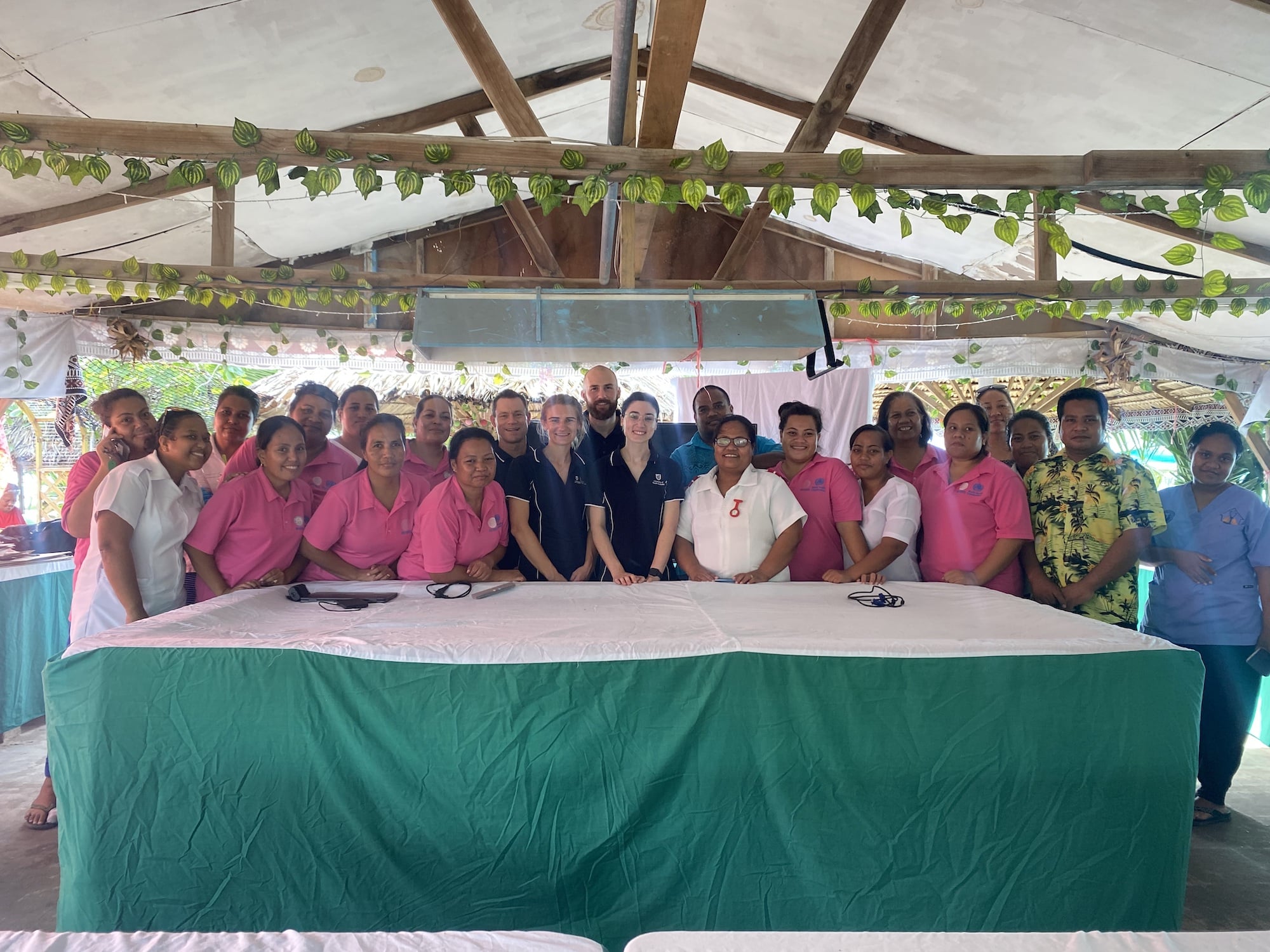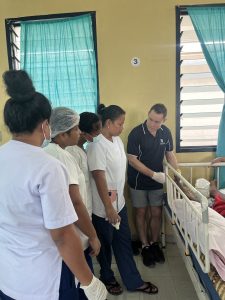
STRIDE interviewed Dr Ryan Causby about the University of South Australia’s podiatry initiative in Kiribati, located in the Pacific Ocean, just across the Equator. With one hospital servicing a population of 100,000 people, and nearly one third of Kiribati’s population aged between 24 to 65 having diabetes, Kiribati certainly benefits from podiatric intervention.
Dr Causby, Program Director for the University of South Australia’s podiatry program, explains how the university students’ podiatric intervention is helping to make a positive difference – and how more help is needed.
 Can you tell us a little about Kiribati?
Can you tell us a little about Kiribati?It’s a really interesting place. Firstly, it’s pronounced ‘Kiribus’ rather than Kiribati. The ‘ti’ in their language, i-Kiribati, actually becomes an ‘s’ sound. Their version of Starbucks (no, it’s not remotely the same), for example, is spelled as ‘Titarbakti’.
Kiribati is the first country past the International Date Line. In fact, if you look at the International Date Line, the little blip which occurs on it is to allow Kiribati to all be in the same time zone. This is because of the broad area that Kiribati covers, which is a total land area of 811 square kilometres. This isn’t a lot, but it’s dispersed over five million square kilometres of ocean.
To put this into perspective, if you were to travel from South Tarawa to Kritimati Island (Kirbati’s Christmas Island), it would take roughly four weeks by boat or a few hours by plane. This is one of the only islands made up of land rather than being a coral atoll.
The capital island of Tarawa, which is the atoll we visit, has a highest point of three metres above sea level, and thus, Kiribati is the first country that’s going to go underwater water for a variety of reasons, including rising sea levels.
The entire population now sits just above 119,000 people, with about half of these people crammed into the main island of Tarawa, which makes for very densely populated living conditions. These conditions invite in a range of issues; not least because the land is sinking. A plan is in place for when this happens but it’s a last resort. Land in Fiji is being bought, for example, with the idea to eventually move some of the population there. Mangroves and other plants are also being planted to try to increase the land mass and support flood management. There is a whole lot more being done in addition to this.
Ironically, Kiribati is also experiencing drought so the water isn’t being replenished very well and is becoming highly salinated, owing to increasing salt levels. The Australian government is building a desalination plant to help with this and donating solar units to help desalinate small sections of water for their wells and other purposes.
Another interesting fact about Kiribati is that it has lots of old ships rusting out on the reefs. These are relics from World War II when Kiribati was an area of significant conflict between America and Japan; a lot of Australian and New Zealand troops were also involved. Its location in the Pacific Ocean represented a pivotal point to transfer food and restock supplies, and the country was under invasion by Japanese troops and the Allied forces at various points. The locals continue to use the old tank tracks as fences for their homes.
When it comes to healthcare, since there is currently only one hospital in Kiribati, most of the healthcare system runs in little clinics across the outer islands. Water is a key issue, given the well water – particularly in Tarawa – is contaminated and highly polluted, owing to the rising sea levels amongst other factors. The health system is heavily reliant on foreign aid, and thus there is poor access to antibiotics. These factors combine to result in many infection control challenges, especially against the backdrop of high diabetes rates in the Kiribati population.
There is a high rate of amputation, owing to a very high prevalence of diabetes, which is accompanied by a need for prosthetists. In fact, 29 per cent of people in Kiribati across the 25 to 64 age group have diabetes.
To put this into perspective, at its highest historical peak, around 13 per cent of Australia’s Aboriginal population reported having diabetes or high blood sugar levels, though this rate continues to be far too high. The University of South Australia runs podiatry initiatives across Aboriginal populations to help address this significant health issue (see further below for more information).
To paint a picture around the impact of diabetes in Kiribati, several elements are involved. Firstly, many people in Kiribati rely on fishing as a source of income, so they’re often out on coral reefs. Next, the dense population in parts of Kiribati leads to cramped living conditions where rats and other rodents exist. Added to this is the high humidity and moist heat, and the fact that many people don’t wear shoes or have access to clean water or antiseptic.
When combined, these elements create a perfect storm for wounds, diabetic foot ulcers and potential amputation. The infection rate is just through the roof, with it not being uncommon for a basic foot wound to very quickly lead to amputation.
We work with the locals to teach them about diabetic feet and the importance of offloading. But more importantly, we teach locals how to manage infections and we share simple solutions to support cleanliness. We also emphasise the importance of dressings and keeping wounds covered, along with sharing advice on how important it is to protect the feet overall.
What really stands out is seeing the difference our students can make. One of our patients had an ulcer for six months. Thankfully, it hadn’t yet led to amputation. So, we went in and showed the patient how to offload and gave a lot of education. Within two weeks, their ulcer was 50 per cent healed and it was gone within another couple of weeks. Interestingly, their vascular supply didn’t appear to be an issue. Most of our patients have a really good vascular supply, so as soon as we address the bacterial burden and offloading the ulcer, they tend to heal well.

The students will respond along the lines of, “Oh, is that all?” And to this, we say, “Yes, that’s all. Let’s see what happens. And while you’re at it, teach your patient a bit about getting their blood glucose levels under control.”
The real magic takes place when the patient returns, fully-healed and the student realises, “Oh, we don’t need all this fancy stuff. We just need to go back to basics.” I enjoy seeing this realisation hit our students.
Through helping others, our students gain a much better understanding into the importance of patient education. They also benefit from a cultural experience where they suddenly need to learn how to think outside the box. It’s very likely that their patients don’t have lots of money or ease of access to antiseptics or dressings, which creates new depths of understanding and empathy. Our students start to become able to manage patients from all walks of life. These are highly valuable transferable skills.
It’s certainly a confronting situation for our students and I love seeing them step up to the plate. It’s not uncommon for triaging to take place in a tent in a car park, with families sleeping under the patients’ beds and cooking in the ward. The wards are wide open, with open windows, and the beds are like what your great-great-grandparent may have slept on; cast iron and very basic.
You see some fascinating things. We’ve had multiple patients with rat bites. We’ve had patients with leprosy. They’re some of the things that really stick in my mind. To make a difference is incredible, and to watch our students become empowered to do this, it’s very rewarding.
What immediately comes to mind is the work our students do in Aboriginal communities, through the university. This experience instills a sense of a much bigger picture in our students and it reaffirms the power of podiatry to make a difference; no matter where they go in their careers.
It’s also not uncommon for our students to volunteer their time in this capacity – whether in Aboriginal communities or abroad – and end up working in these communities over the long-term. One of our podiatry students went to the Pacific Islands to continue his role upon graduating. This was through Motivation Australia, who no longer operate there. He now works in the Solomon Islands to provide care to the Islanders. This passion grew out of that Kiribati visit.
Foreign aid is important to Kiribati, with Australia being involved in this picture. A while back, the University of South Australia collaborated with a group called Motivation Australia who were based in South Australia. At the time, Motivation Australia was working on a range of Kiribati-based initiatives.
Through this collaboration, we learned of an Australian initiative called the New Colombo Plan; funded by the Department of Foreign Affairs and Trade. Part of the plan’s purpose is to raise knowledge of the Indo Pacific region amongst Australian undergraduate students. Through this opportunity, our podiatry students access these cultural experiences while applying their skills to make a difference – and they also learn a lot along the way.
What the people of Kiribati really need are products and material supplies. If you can donate basic dressings like INADINE, Iodosorb and other dressings, that would make a big difference. Likewise, felt for offloading and even post-operative shoes are so scarce in Kiribati. Then we can ship these items across or seek to take them there ourselves. Please email me to discuss this further, if you are in a position to help: Ryan.Causby@unisa.edu.au
In general, the more we can do for the Kiribati population, particularly the healthcare workers who work so hard, the better. It makes me cry when I say to the healthcare workers, “Look, this person really needs a post-op shoe just to offload, so they’ve got something to protect their feet,” and we don’t have anything to offer them. More material supplies would make a big difference.
Far less importantly, while we’ve applied for some government funding to enable our students to provide three visits a year, this doesn’t extend to the university’s teaching staff who will accompany them. We’re obviously trying to these raise funds ourselves to ensure that we can pay for staff to go, but every bit helps, given flights can be expensive – and despite often being basic, accommodation can be highly priced. To discuss this further, please get in touch with me on the above email address.
© Copyright 2021 The Australian Podiatry Association
